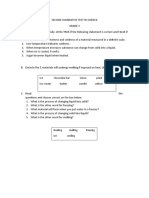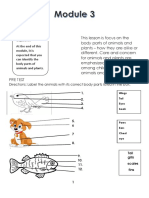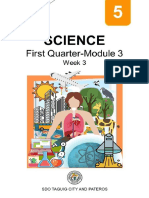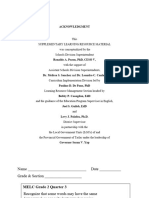0 ratings0% found this document useful (0 votes)
2K viewsParts of A Nose - Science 3
Parts of A Nose - Science 3
Uploaded by
lanie.tanecoThe nose functions to allow smelling odors and help with breathing. It has visible parts like the bridge and tip, and openings called nostrils separated by the septum or columella. Behind the nose is the nasal cavity, connected to the throat, where air passes through and tiny hairs called cilia and mucus work to filter dust and bacteria from the inhaled air before it reaches the lungs.
Copyright:
© All Rights Reserved
Available Formats
Download as DOCX, PDF, TXT or read online from Scribd
Parts of A Nose - Science 3
Parts of A Nose - Science 3
Uploaded by
lanie.taneco0 ratings0% found this document useful (0 votes)
2K views2 pagesThe nose functions to allow smelling odors and help with breathing. It has visible parts like the bridge and tip, and openings called nostrils separated by the septum or columella. Behind the nose is the nasal cavity, connected to the throat, where air passes through and tiny hairs called cilia and mucus work to filter dust and bacteria from the inhaled air before it reaches the lungs.
Original Description:
Parts of a Nose
Original Title
Parts of a Nose - Science 3
Copyright
© © All Rights Reserved
Available Formats
DOCX, PDF, TXT or read online from Scribd
Share this document
Did you find this document useful?
Is this content inappropriate?
The nose functions to allow smelling odors and help with breathing. It has visible parts like the bridge and tip, and openings called nostrils separated by the septum or columella. Behind the nose is the nasal cavity, connected to the throat, where air passes through and tiny hairs called cilia and mucus work to filter dust and bacteria from the inhaled air before it reaches the lungs.
Copyright:
© All Rights Reserved
Available Formats
Download as DOCX, PDF, TXT or read online from Scribd
Download as docx, pdf, or txt
0 ratings0% found this document useful (0 votes)
2K views2 pagesParts of A Nose - Science 3
Parts of A Nose - Science 3
Uploaded by
lanie.tanecoThe nose functions to allow smelling odors and help with breathing. It has visible parts like the bridge and tip, and openings called nostrils separated by the septum or columella. Behind the nose is the nasal cavity, connected to the throat, where air passes through and tiny hairs called cilia and mucus work to filter dust and bacteria from the inhaled air before it reaches the lungs.
Copyright:
© All Rights Reserved
Available Formats
Download as DOCX, PDF, TXT or read online from Scribd
Download as docx, pdf, or txt
You are on page 1of 2
NOSE: sense organ for smelling
FUNCTIONS: allow to smell odors
and help you breathe
PARTS
BRIDGE and TIP: most visible
parts
NOSTRILS: two openings
SEPTUM or COLUMELLA: separated
the nostrils, made of a soft and
flexible bone called CARTILAGE
NASAL CAVITY: located behind the
nose and connected to throat;
air passes through this cavity
as you breathe in and out
PALATE: separates the nasal
cavity from the inner part of
the mouth.
CILIA (plural) CILIUM (singular):
tiny hairs along the inner walls
of the nasal cavity
MUCUS: sticky substance
CILIA and MUCUS remove dust and
bacteria from the air.
As the air passes through the
nostrils, the nose makes the
air warm and moist.
OLFACTORY RECEPTOR CELLS:
specialized parts that send odor
signals
OLFACTORY BULB: received the odor
signals and interpret it.
You might also like
- Grade 2 Mathematics First Periodical Examination ReviewerDocument3 pagesGrade 2 Mathematics First Periodical Examination Reviewerlanie.taneco76% (17)
- Grade 1 MTAP Math Challenge Questions and ReviewerDocument3 pagesGrade 1 MTAP Math Challenge Questions and Reviewerlanie.taneco100% (10)
- Magnets and Magnetism (Grade 3) - Free Printable Tests and Worksheets - HelpTeachingDocument1 pageMagnets and Magnetism (Grade 3) - Free Printable Tests and Worksheets - HelpTeachinglanie.taneco88% (8)
- Math 3.G3Q1W3-Rounding, Comparing and Ordering NumbersDocument22 pagesMath 3.G3Q1W3-Rounding, Comparing and Ordering NumbersHazelBitagaNo ratings yet
- Kasingkahulugan at Kasalungat Set B: Worksheet Made by - All Rights ReservedDocument2 pagesKasingkahulugan at Kasalungat Set B: Worksheet Made by - All Rights Reservedlanie.taneco100% (8)
- Science and Filipino Reviewer Grade 3Document5 pagesScience and Filipino Reviewer Grade 3Janaica CaberNo ratings yet
- Revised Summative Test Based On TOS Science 3 2021Document6 pagesRevised Summative Test Based On TOS Science 3 2021Henry Kahal Orio Jr.100% (1)
- Science Reviewer Grade 1Document5 pagesScience Reviewer Grade 1grace go100% (2)
- TQ SCIENCE - 3 SY 2019-2020 (3rd QTR)Document5 pagesTQ SCIENCE - 3 SY 2019-2020 (3rd QTR)Rofel Corpus50% (2)
- 1-5 Summative Test in Science-III (3rd Quarter)Document12 pages1-5 Summative Test in Science-III (3rd Quarter)KyleZack Rivera100% (4)
- SCIENCE 3-6 Third SUMMATIVE TESTDocument9 pagesSCIENCE 3-6 Third SUMMATIVE TESTLyrendon CariagaNo ratings yet
- Part I. Multiple Choice: Direction: Read Each Question Carefully. Choose The Letter of The CorrectDocument3 pagesPart I. Multiple Choice: Direction: Read Each Question Carefully. Choose The Letter of The CorrectHanna Grace Honrade100% (1)
- Science 3 Q1 - Module 1#Document74 pagesScience 3 Q1 - Module 1#rabalos85No ratings yet
- Christian Living Reviewer - Grade 3 - 103038Document5 pagesChristian Living Reviewer - Grade 3 - 103038Star Fall TutorialNo ratings yet
- MATH Q1 Week 7Document22 pagesMATH Q1 Week 7Belay Corpuz100% (1)
- Assessment Test in Science 3.1Document2 pagesAssessment Test in Science 3.1Caren Mae Punzalan100% (1)
- Math3 q2 Mod6 MultiplicationofWhole v2Document16 pagesMath3 q2 Mod6 MultiplicationofWhole v2Karrel Joy Dela CruzNo ratings yet
- 2nd SUMMATIVE TEST IN SCIENCE MELC BASEDDocument4 pages2nd SUMMATIVE TEST IN SCIENCE MELC BASEDGOLDIE TRONGCONo ratings yet
- Science 3 1ST Quarter Test 1 1Document4 pagesScience 3 1ST Quarter Test 1 1MICHELLE BALABANo ratings yet
- The Sense OrgansDocument6 pagesThe Sense Organsjerome100% (1)
- Grade 4 Q1 2023-2024 Budgeted Lesson English 4Document2 pagesGrade 4 Q1 2023-2024 Budgeted Lesson English 4Marion Vergara Cojotan Velasco0% (1)
- First Periodical Exam in Science 3Document6 pagesFirst Periodical Exam in Science 3Ana De Castro100% (2)
- Q2 - A.Y. 21 22 - G2 - TOS and Periodical ExamDocument6 pagesQ2 - A.Y. 21 22 - G2 - TOS and Periodical ExamSher SherwinNo ratings yet
- Science 4 Quarter 2 Week 1 Activity SheetDocument2 pagesScience 4 Quarter 2 Week 1 Activity Sheetbeverly mazo100% (1)
- 2nd Quarter MathDocument3 pages2nd Quarter MathDaryl Dane Bastillada Cabilla - MacanaNo ratings yet
- Module 3 ScienceDocument13 pagesModule 3 ScienceMichael Jorge Bernales100% (1)
- QUARTER 1 - English Grade 3Document186 pagesQUARTER 1 - English Grade 3Herminia D. LoboNo ratings yet
- First Quarter-Module 3: ScienceDocument12 pagesFirst Quarter-Module 3: ScienceMariel SalazarNo ratings yet
- 3rd Periodical Test in English 3 2 1Document2 pages3rd Periodical Test in English 3 2 1Sherwin Phillip100% (3)
- English 3 - Q2 - Quiz # 1 (Week 1-2)Document4 pagesEnglish 3 - Q2 - Quiz # 1 (Week 1-2)Ferdinand James Pascua100% (3)
- Science 3 Q3 Module 1 Week 1 2 Final EditedDocument27 pagesScience 3 Q3 Module 1 Week 1 2 Final EditedHAZEL CLAUDETTE ABITRIANo ratings yet
- Second Quarterly Test in Math 3 - EnglishDocument3 pagesSecond Quarterly Test in Math 3 - EnglishOLIVIA LUMBRE100% (3)
- Science Reviewer For Gr.3Document43 pagesScience Reviewer For Gr.3ARISTHEA C. LABRADORNo ratings yet
- Mapeh 3 2nd Monthly ExamDocument2 pagesMapeh 3 2nd Monthly ExamArianne OlaeraNo ratings yet
- Science: Quarter 1:week 4 - Module 1 My Little TongueDocument23 pagesScience: Quarter 1:week 4 - Module 1 My Little TongueMIMOYOUNo ratings yet
- 4TH Monthly Mapeh 3Document1 page4TH Monthly Mapeh 3Arianne OlaeraNo ratings yet
- Grade 3 Worksheets-Roy - TiapeDocument8 pagesGrade 3 Worksheets-Roy - TiapeJerbs PacundoNo ratings yet
- Summative Test inDocument17 pagesSummative Test inmina0% (1)
- THIRD SUMMATIVE TEST in SCIENCE Grade 3-6Document9 pagesTHIRD SUMMATIVE TEST in SCIENCE Grade 3-6EpiTaffsNo ratings yet
- 4th QTR Week 1 WORKSHEETS IN SCIENCEDocument2 pages4th QTR Week 1 WORKSHEETS IN SCIENCELhenzky Bernarte100% (2)
- Q2 Week3 English Digraphs SH CHDocument29 pagesQ2 Week3 English Digraphs SH CHEMILYNo ratings yet
- Fourth Quarter Test in Mapeh 3Document4 pagesFourth Quarter Test in Mapeh 3Maricson Bas0% (1)
- NLC Math 3 EnhancementDocument83 pagesNLC Math 3 EnhancementEleanor Gerale MendozaNo ratings yet
- Science 3: Quarter 1Document18 pagesScience 3: Quarter 1Richie MacasarteNo ratings yet
- Grade 4 q1 Summative TestDocument21 pagesGrade 4 q1 Summative TestArlen Paden Cano-AgohobNo ratings yet
- English3 Q4 Module 3 PDFDocument12 pagesEnglish3 Q4 Module 3 PDFAbegail Labrador100% (3)
- Quarter2 1st Summative Test With TOSDocument2 pagesQuarter2 1st Summative Test With TOSimelda d. lampa100% (1)
- Science 3 Quiz BeeDocument7 pagesScience 3 Quiz Beecher Kath100% (1)
- Math3 - q2 - Mod4 - Multiplying 2-3 Numbers by Multiples of 10 and 100 - v1Document14 pagesMath3 - q2 - Mod4 - Multiplying 2-3 Numbers by Multiples of 10 and 100 - v1Serena AlmondNo ratings yet
- Math3 - Q2 - Mod4b - Multiplying 2 Digit Numbers by 2 Digit Numbers Without Regrouping - v1Document21 pagesMath3 - Q2 - Mod4b - Multiplying 2 Digit Numbers by 2 Digit Numbers Without Regrouping - v1Aldien Brigoli LagnasonNo ratings yet
- First Quarter Mathematics 3Document82 pagesFirst Quarter Mathematics 3John Harzel Naga100% (1)
- Pretest Grade 3.scienceDocument6 pagesPretest Grade 3.scienceJoe Marie DizonNo ratings yet
- in Science 4Document24 pagesin Science 4Cesareann A RamosNo ratings yet
- Grade 1 Week 7.docx ModuleDocument3 pagesGrade 1 Week 7.docx ModuleRacquel Supsup50% (2)
- Science: Quarter 1 - Module 3Document14 pagesScience: Quarter 1 - Module 3santovincent425100% (1)
- First Periodical Test in Filipino 3 2022 2023Document3 pagesFirst Periodical Test in Filipino 3 2022 2023Jeckay P. Oida100% (1)
- Math 2 SSES MELC With K To 12 MELC FinalDocument19 pagesMath 2 SSES MELC With K To 12 MELC FinalMarjun BartoloNo ratings yet
- How Matter Changes When Applied With Heat - FINAL07182020Document19 pagesHow Matter Changes When Applied With Heat - FINAL07182020TEAM Knightz100% (1)
- Science4 WLP Q1 Week1-7Document109 pagesScience4 WLP Q1 Week1-7Geraldine Ison ReyesNo ratings yet
- 3rd QTR Module 3 in English 2 Synonyms and Antonyms GrADE 2Document25 pages3rd QTR Module 3 in English 2 Synonyms and Antonyms GrADE 2elena.guarinNo ratings yet
- Grade 3 Summative 2 Quarter 2Document3 pagesGrade 3 Summative 2 Quarter 2KHALEEN OLBES100% (1)
- 1st Peridocal Exam in Science KDocument3 pages1st Peridocal Exam in Science KLenly TasicoNo ratings yet
- Anatomy 7062113972923606793Document4 pagesAnatomy 7062113972923606793Domato Ayaon NawalNo ratings yet
- The Respiratory SystemDocument12 pagesThe Respiratory SystemJEMZPERNo ratings yet
- Jan2019 Devotion 2Document1 pageJan2019 Devotion 2lanie.tanecoNo ratings yet
- Primary Colors For Pre - KDocument1 pagePrimary Colors For Pre - Klanie.tanecoNo ratings yet
- Christ Is Enough Lyrics and ChordsDocument1 pageChrist Is Enough Lyrics and Chordslanie.tanecoNo ratings yet
- Bilang NG Pantig - Interactive WorksheetDocument1 pageBilang NG Pantig - Interactive Worksheetlanie.tanecoNo ratings yet
- Parts of A Plant: Leaf (Leaves) FlowerDocument1 pageParts of A Plant: Leaf (Leaves) Flowerlanie.tanecoNo ratings yet
- When There Is No ComparisonDocument2 pagesWhen There Is No Comparisonlanie.tanecoNo ratings yet
- Tongue and Skin - Science 3Document6 pagesTongue and Skin - Science 3lanie.tanecoNo ratings yet
- Fractions VisualDocument1 pageFractions Visuallanie.tanecoNo ratings yet
- MIMETICSDocument3 pagesMIMETICSlanie.tanecoNo ratings yet
- Pluralnouns PDFDocument1 pagePluralnouns PDFlanie.tanecoNo ratings yet
- Test Present Progressive enDocument0 pagesTest Present Progressive enRaluca AlexandraNo ratings yet
- Anyong TubigDocument10 pagesAnyong Tubiglanie.tanecoNo ratings yet
- Grade 2 - Science: MagnetsDocument2 pagesGrade 2 - Science: Magnetslanie.tanecoNo ratings yet
- Name: The Wrong Word in The Sentence and Write The Correct Adjective in The Space ProvidedDocument4 pagesName: The Wrong Word in The Sentence and Write The Correct Adjective in The Space Providedlanie.tanecoNo ratings yet
- AdminDocument1 pageAdminlanie.tanecoNo ratings yet














































































